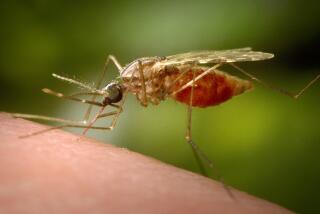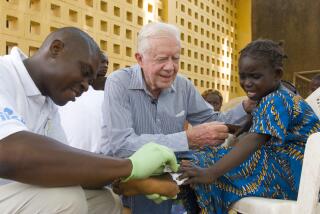The Killer Bug
- Share via
When the sun goes down in Africa, death stalks the children. It seldom comes from jungle cats or venomous snakes, but often from bugs smaller than a toddler’s thumbnail. Every year, their deadly sting kills more people than at Hiroshima and Nagasaki, more than December’s tsunami in Asia, more than the combined Union and Confederate casualties in the Civil War. If a biblical plague slaughtered every man, woman and child in Philadelphia, it would not equal some estimates of the death toll from malaria in the last 12 months.
Well, some might say, the world is full of tragedy. We can’t cure all disease or save all lost children. But these acres of graves are the needless legacy of a disease that we have known how to cure for a century. And each life might have been saved for about $2 — less than the price of a latte.
Public health authorities can only guess how many people die of malaria because most of the victims never make it to a clinic; the estimates range from 1 million to 3 million a year. Most of the dead are children under age 5, and 90% had the misfortune to be born in sub-Saharan Africa, a land trapped somewhere between the modern world and the Stone Age.
A Timeless Disease
Malaria’s origins can’t be traced to a specific time period; the disease may be as old as civilized man (some speculate that it arose around the time humans started clustering in agricultural communities). A Chinese medical text from 2700 BC describes its symptoms. It is a bug carried by a bug— a parasite carried in the salivary glands of the anopheles mosquito. Humans and mosquitoes live in a vicious circle of infection. The mosquito gets the parasite by stinging a human who is already infected with it, then stings an uninfected human and passes it on.The word malaria means “bad air” in Italian, because for centuries people thought that fetid vapors, particularly from swamps, were responsible for its spread. Then, in 1897, a Nobel Prize-winning British physician named Ronald Ross discovered that the mosquito was responsible.
The response around the world was to attack the bloodsuckers where they lived. One of the most successful programs started in 1904, when the U.S. military began draining swamps in the Panama Canal Zone -- malaria and yellow fever were killing or disabling so many workers that the completion of the canal was in jeopardy.
In the 1930s, a similar approach was taken in the American South, where the parasite was thriving. During World War II, DDT was developed and sprayed in millions of U.S. homes. The drugs primaquine and chloroquine were added to the older quinine as effective treatments, and, by 1953, malaria was all but eradicated in the United States.
It was a heady time. The world had seemingly conquered a disease that had shadowed man’s footsteps for millenniums; anything seemed possible. In the late 1950s, the World Health Organization led a campaign to eliminate malaria from the rest of the world, pumping the equivalent of billions of today’s dollars into the quest —an amount that, given today’s politics, seems almost incomprehensible. Workers armed with DDT sprayers descended like Blackhawks over Baghdad on the huts and houses of the Third World.
But the malaria parasite is one of nature’s more perfect killers, and this eradication effort was largely a failure. Malaria rates were reduced in some parts of the world, but in places with a more severe problem than this country had ever faced, the mosquitoes simply started developing resistance to the insecticide. And the DDT armies didn’t even try to fight the bugs in sub-Saharan Africa, where the problem was deemed so severe that such efforts would be pointless. Today, malaria kills more people than ever.
A Very Modest Goal
The WHO failure discouraged ambitious anti-malaria programs for decades. Then, in 1998, the WHO and the World Bank established the Roll Back Malaria partnership. In 2000, the G-8 club of industrialized nations identified three pandemics that it would work to cure, and in 2002 established the Global Fund to Fight AIDS, Tuberculosis and Malaria.A very modest anti-malaria goal was set in 2000 by the United Nations as part of its Millennium Development Goals: to halt and begin to reverse the rise in the incidence of malaria by 2015. The Bill and Melinda Gates Foundation (whose president is married to the editor who supervises this page) also focuses on malaria eradication, further attracting attention to the disease.
Yet the U.S. government spends about half as much on malaria per year as it spends in one day in Iraq. It also places a lower priority on malaria than other diseases, spending 30 to 40 times more in the fight against AIDS than on malaria, maybe because Americans get AIDS but not malaria.
It is absurd, of course, to argue that one global epidemic is more deserving of attention than others. But fighting one disease need not divert resources from the battle against another. And, in the case of malaria, negligence is especially immoral given the cost and effectiveness of available treatment. Anti-malaria combination therapies cost about $2 a treatment in Africa (though that is still far too expensive for large numbers of Africans to afford).
The Sick Continent
Sub-Saharan Africa is an economic sinkhole, stuck in what Columbia University economist Jeffrey Sachs calls a “poverty trap.” Other poor corners of the globe, such as India and East Asia, are making progress, showing marked improvement in per capita income over the last decade and a half. Sub-Saharan Africa is standing still, if not getting poorer. Is it that its governments are too corrupt, or its farming methods too ancient, or its ethnic tensions too corrosive?These are all factors. But none is unique to sub-Saharan Africa, and other places with these problems still have managed to reduce poverty. What is unusual about this region is the burden of disease, more intense than anywhere else on Earth. And one of the most insidious is malaria. The WHO estimates that the disease costs the African economy about $12 billion a year. Just about everyone living in sub-Saharan Africa gets malaria at least once a year. Most survive but suffer from anemia, recurring fevers and physical weakness. Many children also survive an infection, but with impaired physical and cognitive development.
Among the more cruel paradoxes of malaria is that this disease that kills millions of children also fuels overpopulation. In countries with high infant mortality, parents have a grim way of playing the odds, knowing they have to have a lot of children to make up for the ones who won’t make it past the age of 5.
Looking Ahead
The malaria parasite is remarkably complex and adaptable. As soon as scientists discover a new drug to fight it, the parasite starts developing resistance. Ditto for the mosquitoes that carry it, which eventually build resistance to poison sprays.As a result, many health experts, particularly those who remember the WHO failure of the 1950s and ‘60s, are skeptical that malaria can ever be eradicated. But no one doubts that its toll on humankind can be substantially reduced. And even achieving only the U.N.’s millennium goal of reversing the rise of the disease would save thousands, if not millions, of lives.
There won’t be a magic bullet -- the solution will involve a combination of drugs, better availability of treatment, bed nets, insecticide spraying and, ideally, a vaccine. The Gates Foundation is in the process of selecting one country in which it will provide all the available resources, and measure the results. That kind of measurement is critical. Deadly as it is, malaria is rightly considered among the more soluble diseases plaguing Africa, one that can be fought effectively at comparatively low cost, which is why this killer bug is once again drawing so much attention. But unless data are presented showing that anti-malaria programs work, that money will quickly dry up.
In the coming months, The Times will examine some of the key challenges in the battle against malaria. There are solutions, but most come down to one thing: commitment. Most of the world’s richest countries made lofty promises to fight malaria at the turn of the millennium. In the years since, these pledges have not been met.
The result of this failure is a sting of death afflicting millions. The United States and other rich nations have it in their power to easily prevent this sting, and we will have it on our conscience if we fail to do so.
More to Read
Sign up for Essential California
The most important California stories and recommendations in your inbox every morning.
You may occasionally receive promotional content from the Los Angeles Times.













